Leadership and Management Report: Starbucks Operations
VerifiedAdded on 2022/12/28
|12
|3809
|63
Report
AI Summary
This report provides a comprehensive analysis of leadership and management principles within the context of Starbucks. It begins by defining leadership, management, and operations management, and then explores the roles and characteristics of leaders and managers, supported by a PowerPoint presentation. The report examines how leaders and managers function in different situations, such as during a pandemic lockdown and a new product launch, applying theories like bureaucratic and democratic leadership styles. It then delves into various leadership and management theories and models, including situational theory, systems theory, and chaos theory, along with task-oriented and relationship-oriented approaches. The report further investigates different approaches to operations management, such as Six Sigma, Lean production, and queuing theory, alongside approaches like Total Quality Management and Just-in-Time inventory. It concludes by discussing factors that impact operational management, providing a holistic view of leadership and management practices within Starbucks. The report includes references to support the analysis.
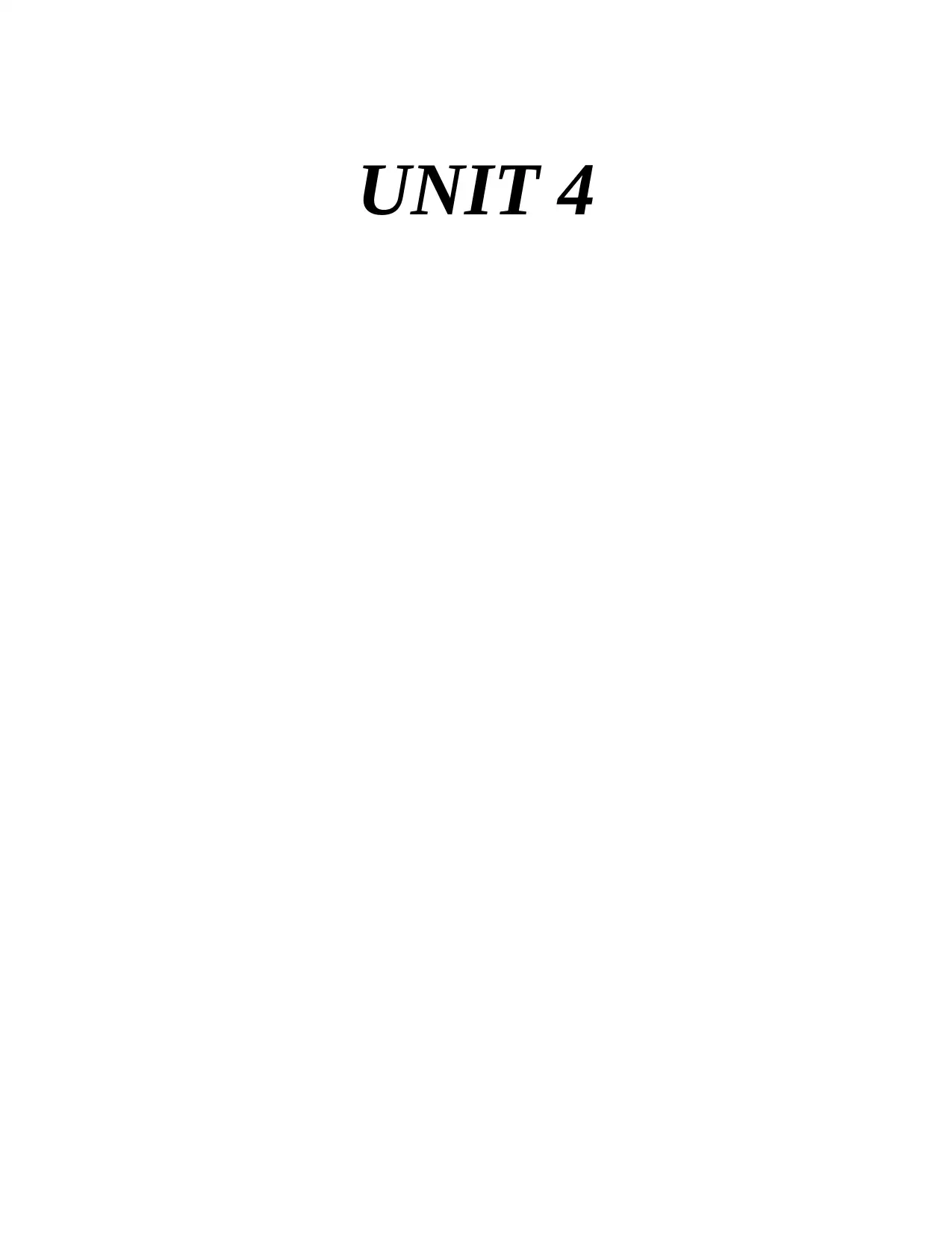
UNIT 4
Paraphrase This Document
Need a fresh take? Get an instant paraphrase of this document with our AI Paraphraser
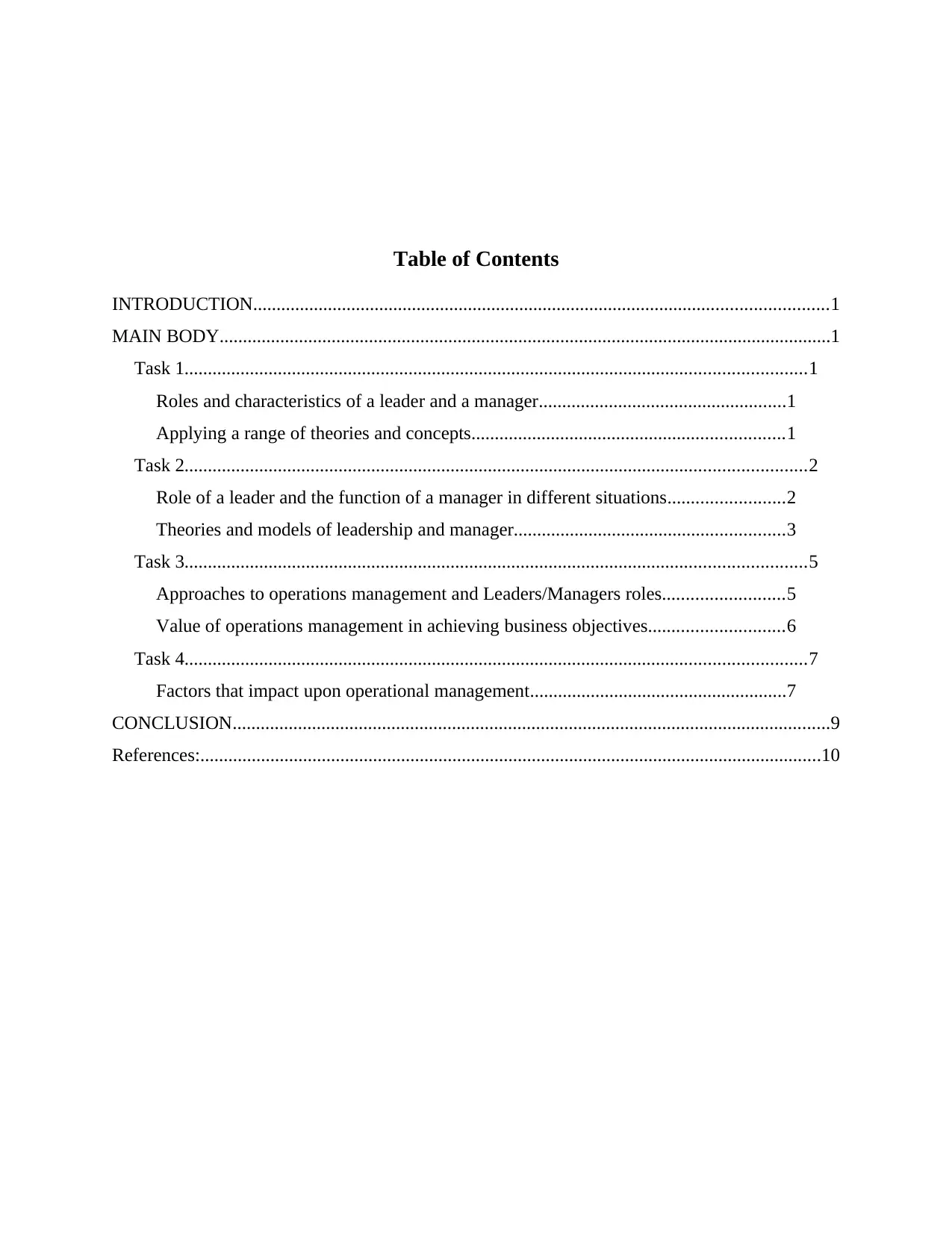
Table of Contents
INTRODUCTION...........................................................................................................................1
MAIN BODY...................................................................................................................................1
Task 1.....................................................................................................................................1
Roles and characteristics of a leader and a manager.....................................................1
Applying a range of theories and concepts...................................................................1
Task 2.....................................................................................................................................2
Role of a leader and the function of a manager in different situations.........................2
Theories and models of leadership and manager..........................................................3
Task 3.....................................................................................................................................5
Approaches to operations management and Leaders/Managers roles..........................5
Value of operations management in achieving business objectives.............................6
Task 4.....................................................................................................................................7
Factors that impact upon operational management.......................................................7
CONCLUSION................................................................................................................................9
References:.....................................................................................................................................10
INTRODUCTION...........................................................................................................................1
MAIN BODY...................................................................................................................................1
Task 1.....................................................................................................................................1
Roles and characteristics of a leader and a manager.....................................................1
Applying a range of theories and concepts...................................................................1
Task 2.....................................................................................................................................2
Role of a leader and the function of a manager in different situations.........................2
Theories and models of leadership and manager..........................................................3
Task 3.....................................................................................................................................5
Approaches to operations management and Leaders/Managers roles..........................5
Value of operations management in achieving business objectives.............................6
Task 4.....................................................................................................................................7
Factors that impact upon operational management.......................................................7
CONCLUSION................................................................................................................................9
References:.....................................................................................................................................10
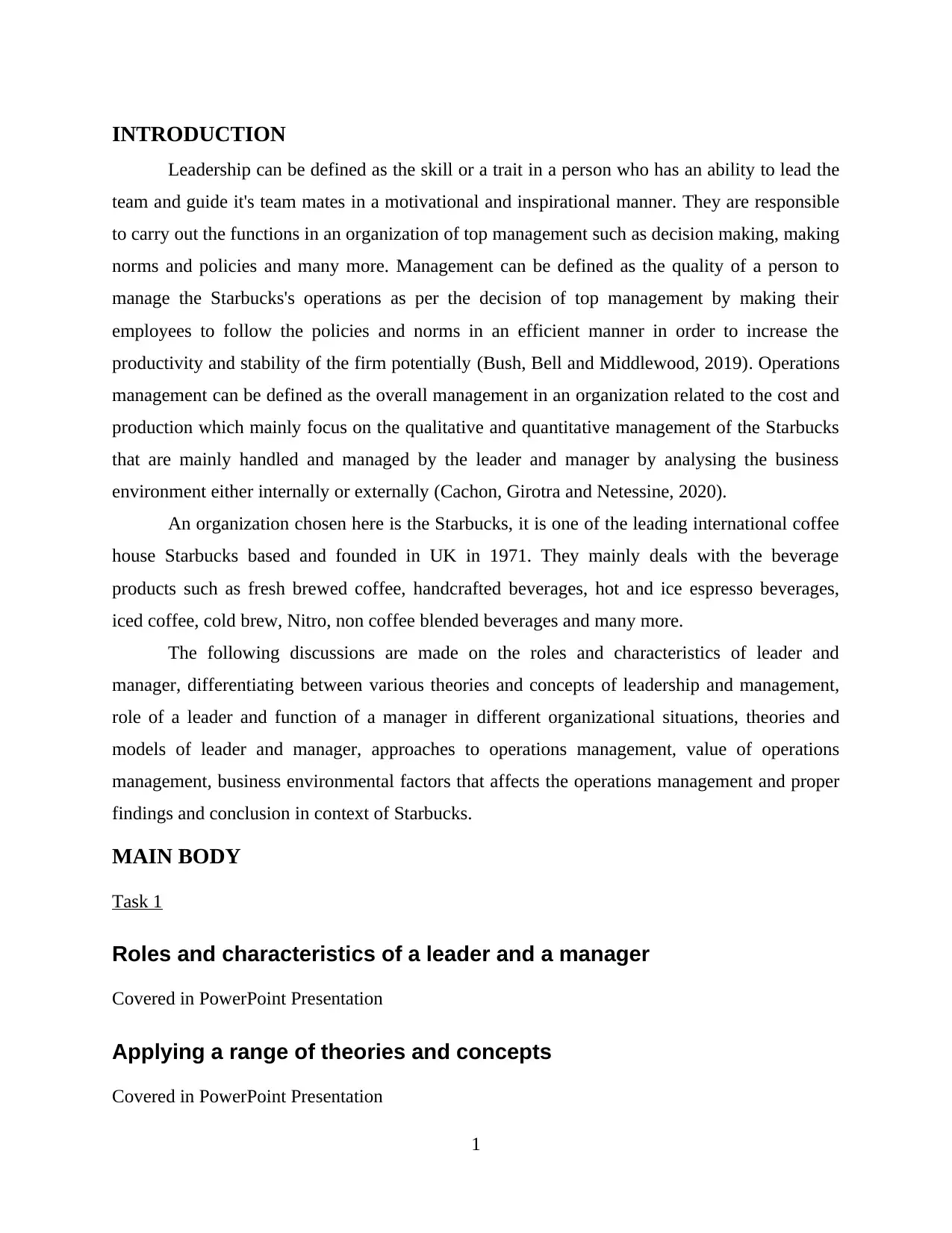
INTRODUCTION
Leadership can be defined as the skill or a trait in a person who has an ability to lead the
team and guide it's team mates in a motivational and inspirational manner. They are responsible
to carry out the functions in an organization of top management such as decision making, making
norms and policies and many more. Management can be defined as the quality of a person to
manage the Starbucks's operations as per the decision of top management by making their
employees to follow the policies and norms in an efficient manner in order to increase the
productivity and stability of the firm potentially (Bush, Bell and Middlewood, 2019). Operations
management can be defined as the overall management in an organization related to the cost and
production which mainly focus on the qualitative and quantitative management of the Starbucks
that are mainly handled and managed by the leader and manager by analysing the business
environment either internally or externally (Cachon, Girotra and Netessine, 2020).
An organization chosen here is the Starbucks, it is one of the leading international coffee
house Starbucks based and founded in UK in 1971. They mainly deals with the beverage
products such as fresh brewed coffee, handcrafted beverages, hot and ice espresso beverages,
iced coffee, cold brew, Nitro, non coffee blended beverages and many more.
The following discussions are made on the roles and characteristics of leader and
manager, differentiating between various theories and concepts of leadership and management,
role of a leader and function of a manager in different organizational situations, theories and
models of leader and manager, approaches to operations management, value of operations
management, business environmental factors that affects the operations management and proper
findings and conclusion in context of Starbucks.
MAIN BODY
Task 1
Roles and characteristics of a leader and a manager
Covered in PowerPoint Presentation
Applying a range of theories and concepts
Covered in PowerPoint Presentation
1
Leadership can be defined as the skill or a trait in a person who has an ability to lead the
team and guide it's team mates in a motivational and inspirational manner. They are responsible
to carry out the functions in an organization of top management such as decision making, making
norms and policies and many more. Management can be defined as the quality of a person to
manage the Starbucks's operations as per the decision of top management by making their
employees to follow the policies and norms in an efficient manner in order to increase the
productivity and stability of the firm potentially (Bush, Bell and Middlewood, 2019). Operations
management can be defined as the overall management in an organization related to the cost and
production which mainly focus on the qualitative and quantitative management of the Starbucks
that are mainly handled and managed by the leader and manager by analysing the business
environment either internally or externally (Cachon, Girotra and Netessine, 2020).
An organization chosen here is the Starbucks, it is one of the leading international coffee
house Starbucks based and founded in UK in 1971. They mainly deals with the beverage
products such as fresh brewed coffee, handcrafted beverages, hot and ice espresso beverages,
iced coffee, cold brew, Nitro, non coffee blended beverages and many more.
The following discussions are made on the roles and characteristics of leader and
manager, differentiating between various theories and concepts of leadership and management,
role of a leader and function of a manager in different organizational situations, theories and
models of leader and manager, approaches to operations management, value of operations
management, business environmental factors that affects the operations management and proper
findings and conclusion in context of Starbucks.
MAIN BODY
Task 1
Roles and characteristics of a leader and a manager
Covered in PowerPoint Presentation
Applying a range of theories and concepts
Covered in PowerPoint Presentation
1
⊘ This is a preview!⊘
Do you want full access?
Subscribe today to unlock all pages.

Trusted by 1+ million students worldwide
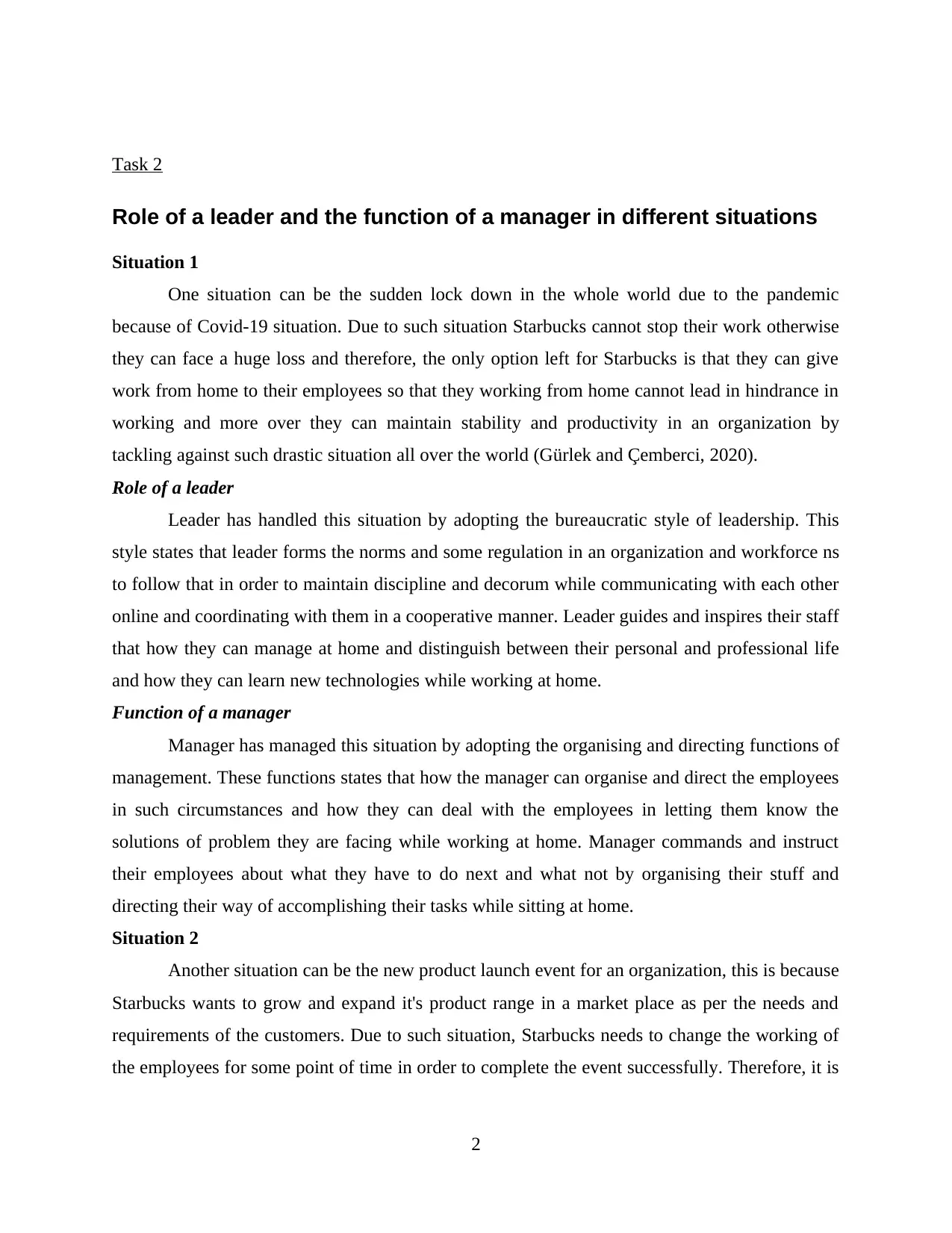
Task 2
Role of a leader and the function of a manager in different situations
Situation 1
One situation can be the sudden lock down in the whole world due to the pandemic
because of Covid-19 situation. Due to such situation Starbucks cannot stop their work otherwise
they can face a huge loss and therefore, the only option left for Starbucks is that they can give
work from home to their employees so that they working from home cannot lead in hindrance in
working and more over they can maintain stability and productivity in an organization by
tackling against such drastic situation all over the world (Gürlek and Çemberci, 2020).
Role of a leader
Leader has handled this situation by adopting the bureaucratic style of leadership. This
style states that leader forms the norms and some regulation in an organization and workforce ns
to follow that in order to maintain discipline and decorum while communicating with each other
online and coordinating with them in a cooperative manner. Leader guides and inspires their staff
that how they can manage at home and distinguish between their personal and professional life
and how they can learn new technologies while working at home.
Function of a manager
Manager has managed this situation by adopting the organising and directing functions of
management. These functions states that how the manager can organise and direct the employees
in such circumstances and how they can deal with the employees in letting them know the
solutions of problem they are facing while working at home. Manager commands and instruct
their employees about what they have to do next and what not by organising their stuff and
directing their way of accomplishing their tasks while sitting at home.
Situation 2
Another situation can be the new product launch event for an organization, this is because
Starbucks wants to grow and expand it's product range in a market place as per the needs and
requirements of the customers. Due to such situation, Starbucks needs to change the working of
the employees for some point of time in order to complete the event successfully. Therefore, it is
2
Role of a leader and the function of a manager in different situations
Situation 1
One situation can be the sudden lock down in the whole world due to the pandemic
because of Covid-19 situation. Due to such situation Starbucks cannot stop their work otherwise
they can face a huge loss and therefore, the only option left for Starbucks is that they can give
work from home to their employees so that they working from home cannot lead in hindrance in
working and more over they can maintain stability and productivity in an organization by
tackling against such drastic situation all over the world (Gürlek and Çemberci, 2020).
Role of a leader
Leader has handled this situation by adopting the bureaucratic style of leadership. This
style states that leader forms the norms and some regulation in an organization and workforce ns
to follow that in order to maintain discipline and decorum while communicating with each other
online and coordinating with them in a cooperative manner. Leader guides and inspires their staff
that how they can manage at home and distinguish between their personal and professional life
and how they can learn new technologies while working at home.
Function of a manager
Manager has managed this situation by adopting the organising and directing functions of
management. These functions states that how the manager can organise and direct the employees
in such circumstances and how they can deal with the employees in letting them know the
solutions of problem they are facing while working at home. Manager commands and instruct
their employees about what they have to do next and what not by organising their stuff and
directing their way of accomplishing their tasks while sitting at home.
Situation 2
Another situation can be the new product launch event for an organization, this is because
Starbucks wants to grow and expand it's product range in a market place as per the needs and
requirements of the customers. Due to such situation, Starbucks needs to change the working of
the employees for some point of time in order to complete the event successfully. Therefore, it is
2
Paraphrase This Document
Need a fresh take? Get an instant paraphrase of this document with our AI Paraphraser
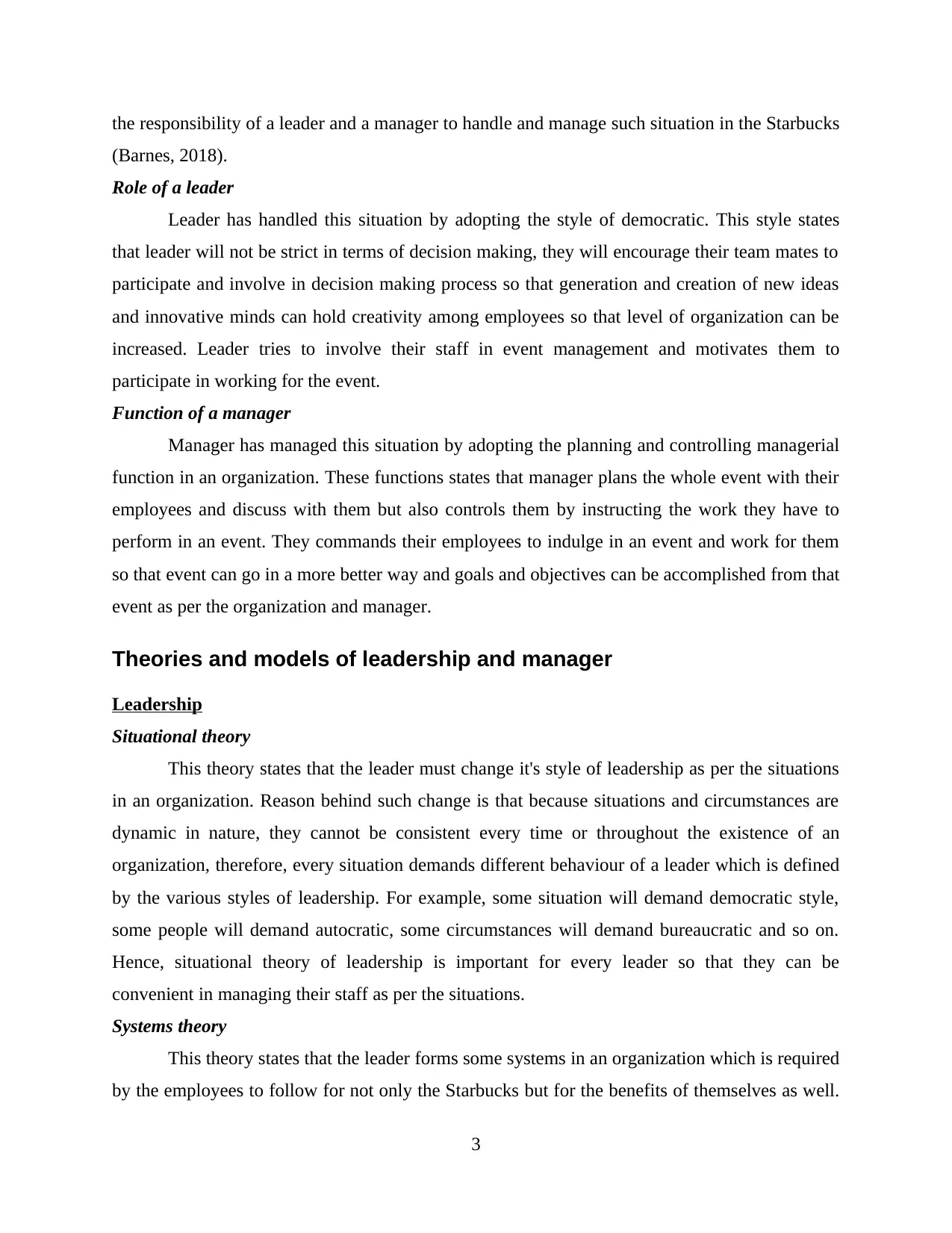
the responsibility of a leader and a manager to handle and manage such situation in the Starbucks
(Barnes, 2018).
Role of a leader
Leader has handled this situation by adopting the style of democratic. This style states
that leader will not be strict in terms of decision making, they will encourage their team mates to
participate and involve in decision making process so that generation and creation of new ideas
and innovative minds can hold creativity among employees so that level of organization can be
increased. Leader tries to involve their staff in event management and motivates them to
participate in working for the event.
Function of a manager
Manager has managed this situation by adopting the planning and controlling managerial
function in an organization. These functions states that manager plans the whole event with their
employees and discuss with them but also controls them by instructing the work they have to
perform in an event. They commands their employees to indulge in an event and work for them
so that event can go in a more better way and goals and objectives can be accomplished from that
event as per the organization and manager.
Theories and models of leadership and manager
Leadership
Situational theory
This theory states that the leader must change it's style of leadership as per the situations
in an organization. Reason behind such change is that because situations and circumstances are
dynamic in nature, they cannot be consistent every time or throughout the existence of an
organization, therefore, every situation demands different behaviour of a leader which is defined
by the various styles of leadership. For example, some situation will demand democratic style,
some people will demand autocratic, some circumstances will demand bureaucratic and so on.
Hence, situational theory of leadership is important for every leader so that they can be
convenient in managing their staff as per the situations.
Systems theory
This theory states that the leader forms some systems in an organization which is required
by the employees to follow for not only the Starbucks but for the benefits of themselves as well.
3
(Barnes, 2018).
Role of a leader
Leader has handled this situation by adopting the style of democratic. This style states
that leader will not be strict in terms of decision making, they will encourage their team mates to
participate and involve in decision making process so that generation and creation of new ideas
and innovative minds can hold creativity among employees so that level of organization can be
increased. Leader tries to involve their staff in event management and motivates them to
participate in working for the event.
Function of a manager
Manager has managed this situation by adopting the planning and controlling managerial
function in an organization. These functions states that manager plans the whole event with their
employees and discuss with them but also controls them by instructing the work they have to
perform in an event. They commands their employees to indulge in an event and work for them
so that event can go in a more better way and goals and objectives can be accomplished from that
event as per the organization and manager.
Theories and models of leadership and manager
Leadership
Situational theory
This theory states that the leader must change it's style of leadership as per the situations
in an organization. Reason behind such change is that because situations and circumstances are
dynamic in nature, they cannot be consistent every time or throughout the existence of an
organization, therefore, every situation demands different behaviour of a leader which is defined
by the various styles of leadership. For example, some situation will demand democratic style,
some people will demand autocratic, some circumstances will demand bureaucratic and so on.
Hence, situational theory of leadership is important for every leader so that they can be
convenient in managing their staff as per the situations.
Systems theory
This theory states that the leader forms some systems in an organization which is required
by the employees to follow for not only the Starbucks but for the benefits of themselves as well.
3
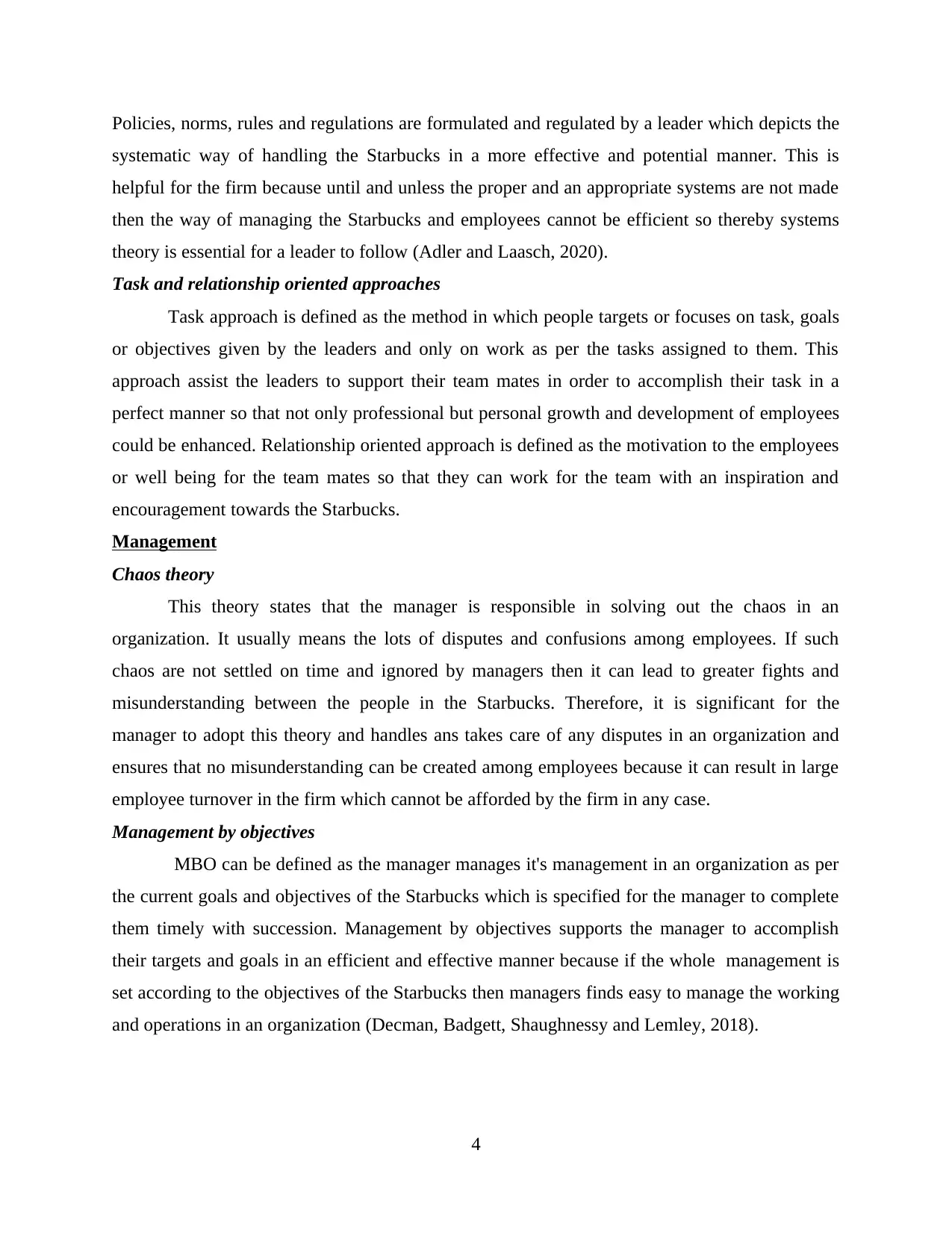
Policies, norms, rules and regulations are formulated and regulated by a leader which depicts the
systematic way of handling the Starbucks in a more effective and potential manner. This is
helpful for the firm because until and unless the proper and an appropriate systems are not made
then the way of managing the Starbucks and employees cannot be efficient so thereby systems
theory is essential for a leader to follow (Adler and Laasch, 2020).
Task and relationship oriented approaches
Task approach is defined as the method in which people targets or focuses on task, goals
or objectives given by the leaders and only on work as per the tasks assigned to them. This
approach assist the leaders to support their team mates in order to accomplish their task in a
perfect manner so that not only professional but personal growth and development of employees
could be enhanced. Relationship oriented approach is defined as the motivation to the employees
or well being for the team mates so that they can work for the team with an inspiration and
encouragement towards the Starbucks.
Management
Chaos theory
This theory states that the manager is responsible in solving out the chaos in an
organization. It usually means the lots of disputes and confusions among employees. If such
chaos are not settled on time and ignored by managers then it can lead to greater fights and
misunderstanding between the people in the Starbucks. Therefore, it is significant for the
manager to adopt this theory and handles ans takes care of any disputes in an organization and
ensures that no misunderstanding can be created among employees because it can result in large
employee turnover in the firm which cannot be afforded by the firm in any case.
Management by objectives
MBO can be defined as the manager manages it's management in an organization as per
the current goals and objectives of the Starbucks which is specified for the manager to complete
them timely with succession. Management by objectives supports the manager to accomplish
their targets and goals in an efficient and effective manner because if the whole management is
set according to the objectives of the Starbucks then managers finds easy to manage the working
and operations in an organization (Decman, Badgett, Shaughnessy and Lemley, 2018).
4
systematic way of handling the Starbucks in a more effective and potential manner. This is
helpful for the firm because until and unless the proper and an appropriate systems are not made
then the way of managing the Starbucks and employees cannot be efficient so thereby systems
theory is essential for a leader to follow (Adler and Laasch, 2020).
Task and relationship oriented approaches
Task approach is defined as the method in which people targets or focuses on task, goals
or objectives given by the leaders and only on work as per the tasks assigned to them. This
approach assist the leaders to support their team mates in order to accomplish their task in a
perfect manner so that not only professional but personal growth and development of employees
could be enhanced. Relationship oriented approach is defined as the motivation to the employees
or well being for the team mates so that they can work for the team with an inspiration and
encouragement towards the Starbucks.
Management
Chaos theory
This theory states that the manager is responsible in solving out the chaos in an
organization. It usually means the lots of disputes and confusions among employees. If such
chaos are not settled on time and ignored by managers then it can lead to greater fights and
misunderstanding between the people in the Starbucks. Therefore, it is significant for the
manager to adopt this theory and handles ans takes care of any disputes in an organization and
ensures that no misunderstanding can be created among employees because it can result in large
employee turnover in the firm which cannot be afforded by the firm in any case.
Management by objectives
MBO can be defined as the manager manages it's management in an organization as per
the current goals and objectives of the Starbucks which is specified for the manager to complete
them timely with succession. Management by objectives supports the manager to accomplish
their targets and goals in an efficient and effective manner because if the whole management is
set according to the objectives of the Starbucks then managers finds easy to manage the working
and operations in an organization (Decman, Badgett, Shaughnessy and Lemley, 2018).
4
⊘ This is a preview!⊘
Do you want full access?
Subscribe today to unlock all pages.

Trusted by 1+ million students worldwide
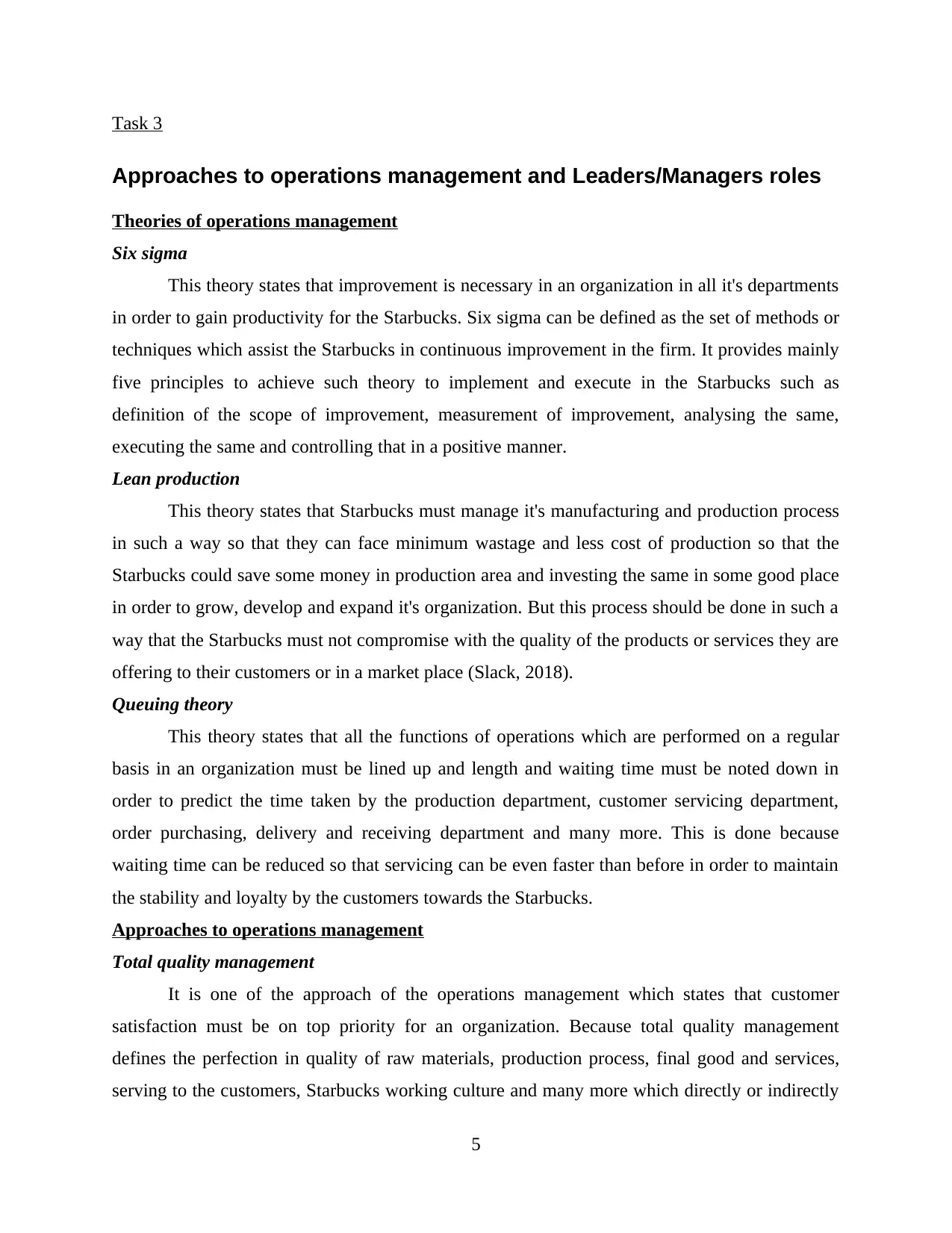
Task 3
Approaches to operations management and Leaders/Managers roles
Theories of operations management
Six sigma
This theory states that improvement is necessary in an organization in all it's departments
in order to gain productivity for the Starbucks. Six sigma can be defined as the set of methods or
techniques which assist the Starbucks in continuous improvement in the firm. It provides mainly
five principles to achieve such theory to implement and execute in the Starbucks such as
definition of the scope of improvement, measurement of improvement, analysing the same,
executing the same and controlling that in a positive manner.
Lean production
This theory states that Starbucks must manage it's manufacturing and production process
in such a way so that they can face minimum wastage and less cost of production so that the
Starbucks could save some money in production area and investing the same in some good place
in order to grow, develop and expand it's organization. But this process should be done in such a
way that the Starbucks must not compromise with the quality of the products or services they are
offering to their customers or in a market place (Slack, 2018).
Queuing theory
This theory states that all the functions of operations which are performed on a regular
basis in an organization must be lined up and length and waiting time must be noted down in
order to predict the time taken by the production department, customer servicing department,
order purchasing, delivery and receiving department and many more. This is done because
waiting time can be reduced so that servicing can be even faster than before in order to maintain
the stability and loyalty by the customers towards the Starbucks.
Approaches to operations management
Total quality management
It is one of the approach of the operations management which states that customer
satisfaction must be on top priority for an organization. Because total quality management
defines the perfection in quality of raw materials, production process, final good and services,
serving to the customers, Starbucks working culture and many more which directly or indirectly
5
Approaches to operations management and Leaders/Managers roles
Theories of operations management
Six sigma
This theory states that improvement is necessary in an organization in all it's departments
in order to gain productivity for the Starbucks. Six sigma can be defined as the set of methods or
techniques which assist the Starbucks in continuous improvement in the firm. It provides mainly
five principles to achieve such theory to implement and execute in the Starbucks such as
definition of the scope of improvement, measurement of improvement, analysing the same,
executing the same and controlling that in a positive manner.
Lean production
This theory states that Starbucks must manage it's manufacturing and production process
in such a way so that they can face minimum wastage and less cost of production so that the
Starbucks could save some money in production area and investing the same in some good place
in order to grow, develop and expand it's organization. But this process should be done in such a
way that the Starbucks must not compromise with the quality of the products or services they are
offering to their customers or in a market place (Slack, 2018).
Queuing theory
This theory states that all the functions of operations which are performed on a regular
basis in an organization must be lined up and length and waiting time must be noted down in
order to predict the time taken by the production department, customer servicing department,
order purchasing, delivery and receiving department and many more. This is done because
waiting time can be reduced so that servicing can be even faster than before in order to maintain
the stability and loyalty by the customers towards the Starbucks.
Approaches to operations management
Total quality management
It is one of the approach of the operations management which states that customer
satisfaction must be on top priority for an organization. Because total quality management
defines the perfection in quality of raw materials, production process, final good and services,
serving to the customers, Starbucks working culture and many more which directly or indirectly
5
Paraphrase This Document
Need a fresh take? Get an instant paraphrase of this document with our AI Paraphraser
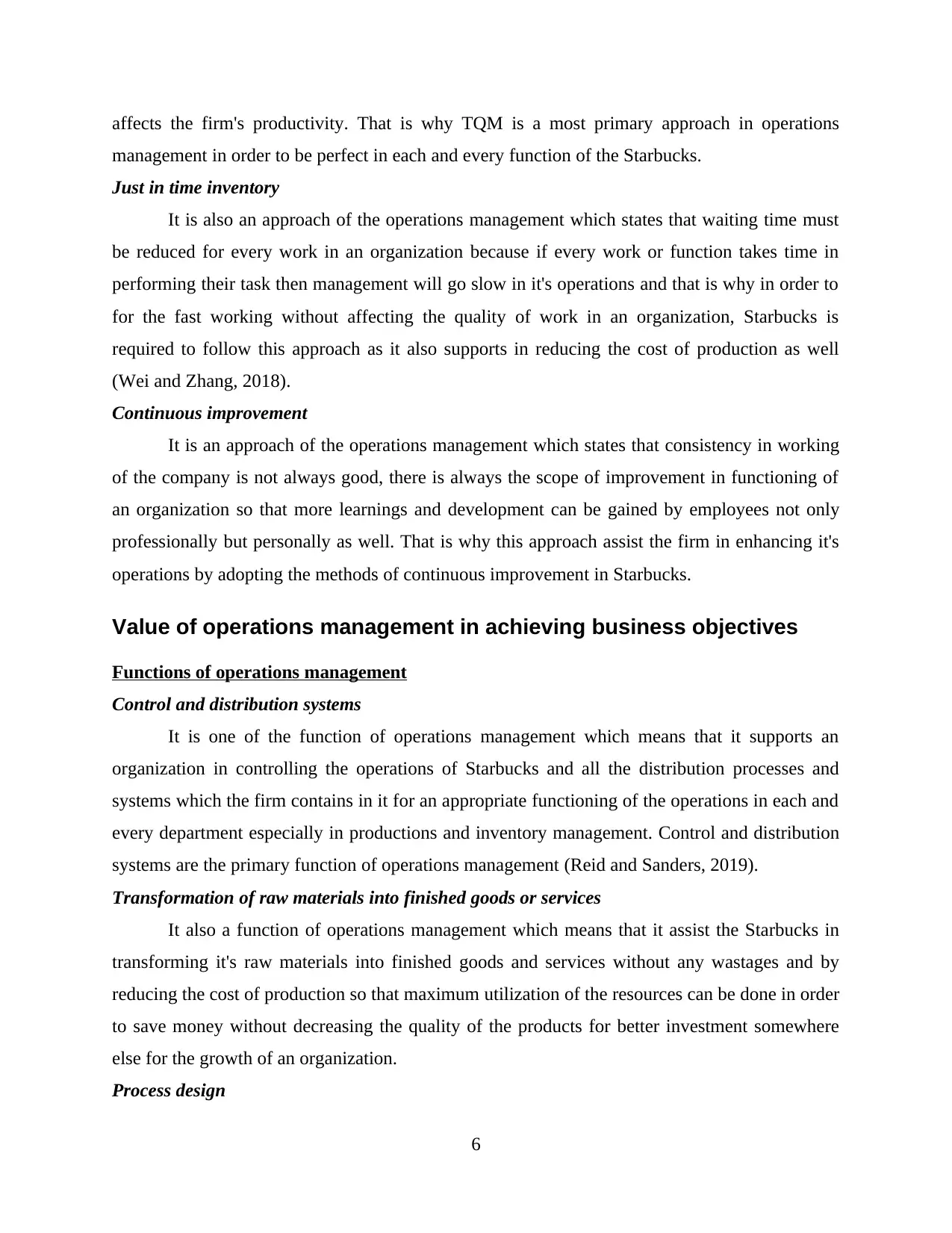
affects the firm's productivity. That is why TQM is a most primary approach in operations
management in order to be perfect in each and every function of the Starbucks.
Just in time inventory
It is also an approach of the operations management which states that waiting time must
be reduced for every work in an organization because if every work or function takes time in
performing their task then management will go slow in it's operations and that is why in order to
for the fast working without affecting the quality of work in an organization, Starbucks is
required to follow this approach as it also supports in reducing the cost of production as well
(Wei and Zhang, 2018).
Continuous improvement
It is an approach of the operations management which states that consistency in working
of the company is not always good, there is always the scope of improvement in functioning of
an organization so that more learnings and development can be gained by employees not only
professionally but personally as well. That is why this approach assist the firm in enhancing it's
operations by adopting the methods of continuous improvement in Starbucks.
Value of operations management in achieving business objectives
Functions of operations management
Control and distribution systems
It is one of the function of operations management which means that it supports an
organization in controlling the operations of Starbucks and all the distribution processes and
systems which the firm contains in it for an appropriate functioning of the operations in each and
every department especially in productions and inventory management. Control and distribution
systems are the primary function of operations management (Reid and Sanders, 2019).
Transformation of raw materials into finished goods or services
It also a function of operations management which means that it assist the Starbucks in
transforming it's raw materials into finished goods and services without any wastages and by
reducing the cost of production so that maximum utilization of the resources can be done in order
to save money without decreasing the quality of the products for better investment somewhere
else for the growth of an organization.
Process design
6
management in order to be perfect in each and every function of the Starbucks.
Just in time inventory
It is also an approach of the operations management which states that waiting time must
be reduced for every work in an organization because if every work or function takes time in
performing their task then management will go slow in it's operations and that is why in order to
for the fast working without affecting the quality of work in an organization, Starbucks is
required to follow this approach as it also supports in reducing the cost of production as well
(Wei and Zhang, 2018).
Continuous improvement
It is an approach of the operations management which states that consistency in working
of the company is not always good, there is always the scope of improvement in functioning of
an organization so that more learnings and development can be gained by employees not only
professionally but personally as well. That is why this approach assist the firm in enhancing it's
operations by adopting the methods of continuous improvement in Starbucks.
Value of operations management in achieving business objectives
Functions of operations management
Control and distribution systems
It is one of the function of operations management which means that it supports an
organization in controlling the operations of Starbucks and all the distribution processes and
systems which the firm contains in it for an appropriate functioning of the operations in each and
every department especially in productions and inventory management. Control and distribution
systems are the primary function of operations management (Reid and Sanders, 2019).
Transformation of raw materials into finished goods or services
It also a function of operations management which means that it assist the Starbucks in
transforming it's raw materials into finished goods and services without any wastages and by
reducing the cost of production so that maximum utilization of the resources can be done in order
to save money without decreasing the quality of the products for better investment somewhere
else for the growth of an organization.
Process design
6
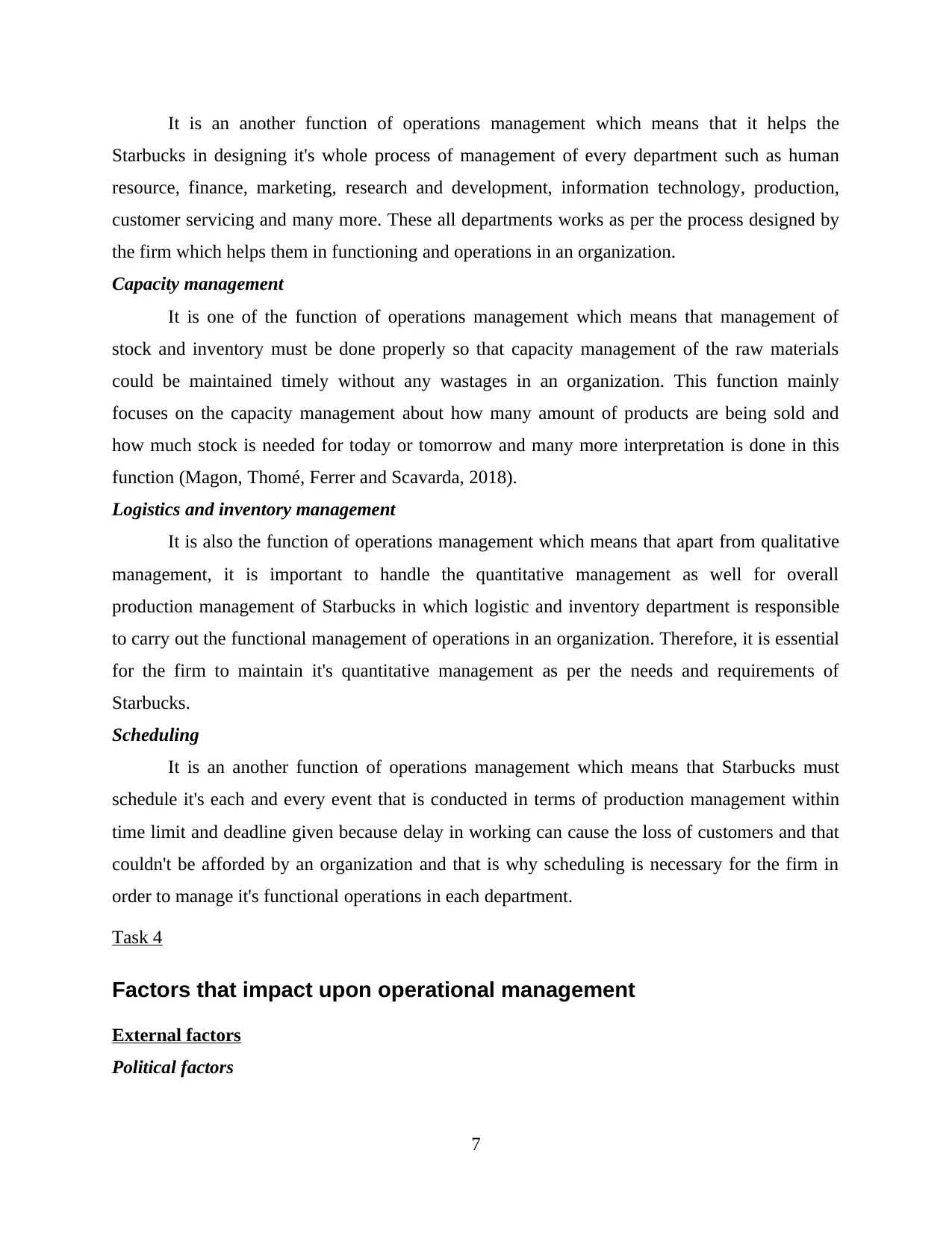
It is an another function of operations management which means that it helps the
Starbucks in designing it's whole process of management of every department such as human
resource, finance, marketing, research and development, information technology, production,
customer servicing and many more. These all departments works as per the process designed by
the firm which helps them in functioning and operations in an organization.
Capacity management
It is one of the function of operations management which means that management of
stock and inventory must be done properly so that capacity management of the raw materials
could be maintained timely without any wastages in an organization. This function mainly
focuses on the capacity management about how many amount of products are being sold and
how much stock is needed for today or tomorrow and many more interpretation is done in this
function (Magon, Thomé, Ferrer and Scavarda, 2018).
Logistics and inventory management
It is also the function of operations management which means that apart from qualitative
management, it is important to handle the quantitative management as well for overall
production management of Starbucks in which logistic and inventory department is responsible
to carry out the functional management of operations in an organization. Therefore, it is essential
for the firm to maintain it's quantitative management as per the needs and requirements of
Starbucks.
Scheduling
It is an another function of operations management which means that Starbucks must
schedule it's each and every event that is conducted in terms of production management within
time limit and deadline given because delay in working can cause the loss of customers and that
couldn't be afforded by an organization and that is why scheduling is necessary for the firm in
order to manage it's functional operations in each department.
Task 4
Factors that impact upon operational management
External factors
Political factors
7
Starbucks in designing it's whole process of management of every department such as human
resource, finance, marketing, research and development, information technology, production,
customer servicing and many more. These all departments works as per the process designed by
the firm which helps them in functioning and operations in an organization.
Capacity management
It is one of the function of operations management which means that management of
stock and inventory must be done properly so that capacity management of the raw materials
could be maintained timely without any wastages in an organization. This function mainly
focuses on the capacity management about how many amount of products are being sold and
how much stock is needed for today or tomorrow and many more interpretation is done in this
function (Magon, Thomé, Ferrer and Scavarda, 2018).
Logistics and inventory management
It is also the function of operations management which means that apart from qualitative
management, it is important to handle the quantitative management as well for overall
production management of Starbucks in which logistic and inventory department is responsible
to carry out the functional management of operations in an organization. Therefore, it is essential
for the firm to maintain it's quantitative management as per the needs and requirements of
Starbucks.
Scheduling
It is an another function of operations management which means that Starbucks must
schedule it's each and every event that is conducted in terms of production management within
time limit and deadline given because delay in working can cause the loss of customers and that
couldn't be afforded by an organization and that is why scheduling is necessary for the firm in
order to manage it's functional operations in each department.
Task 4
Factors that impact upon operational management
External factors
Political factors
7
⊘ This is a preview!⊘
Do you want full access?
Subscribe today to unlock all pages.

Trusted by 1+ million students worldwide
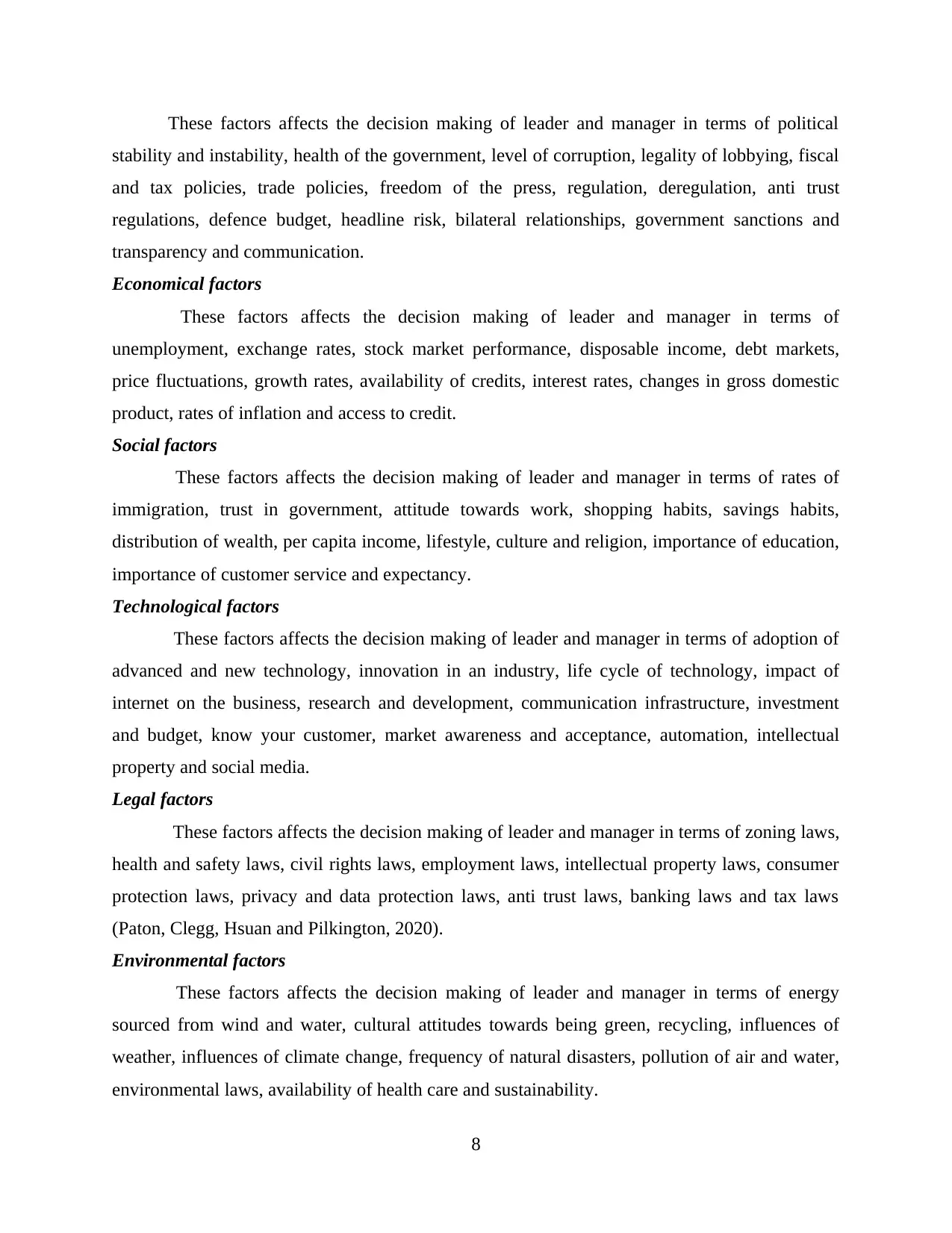
These factors affects the decision making of leader and manager in terms of political
stability and instability, health of the government, level of corruption, legality of lobbying, fiscal
and tax policies, trade policies, freedom of the press, regulation, deregulation, anti trust
regulations, defence budget, headline risk, bilateral relationships, government sanctions and
transparency and communication.
Economical factors
These factors affects the decision making of leader and manager in terms of
unemployment, exchange rates, stock market performance, disposable income, debt markets,
price fluctuations, growth rates, availability of credits, interest rates, changes in gross domestic
product, rates of inflation and access to credit.
Social factors
These factors affects the decision making of leader and manager in terms of rates of
immigration, trust in government, attitude towards work, shopping habits, savings habits,
distribution of wealth, per capita income, lifestyle, culture and religion, importance of education,
importance of customer service and expectancy.
Technological factors
These factors affects the decision making of leader and manager in terms of adoption of
advanced and new technology, innovation in an industry, life cycle of technology, impact of
internet on the business, research and development, communication infrastructure, investment
and budget, know your customer, market awareness and acceptance, automation, intellectual
property and social media.
Legal factors
These factors affects the decision making of leader and manager in terms of zoning laws,
health and safety laws, civil rights laws, employment laws, intellectual property laws, consumer
protection laws, privacy and data protection laws, anti trust laws, banking laws and tax laws
(Paton, Clegg, Hsuan and Pilkington, 2020).
Environmental factors
These factors affects the decision making of leader and manager in terms of energy
sourced from wind and water, cultural attitudes towards being green, recycling, influences of
weather, influences of climate change, frequency of natural disasters, pollution of air and water,
environmental laws, availability of health care and sustainability.
8
stability and instability, health of the government, level of corruption, legality of lobbying, fiscal
and tax policies, trade policies, freedom of the press, regulation, deregulation, anti trust
regulations, defence budget, headline risk, bilateral relationships, government sanctions and
transparency and communication.
Economical factors
These factors affects the decision making of leader and manager in terms of
unemployment, exchange rates, stock market performance, disposable income, debt markets,
price fluctuations, growth rates, availability of credits, interest rates, changes in gross domestic
product, rates of inflation and access to credit.
Social factors
These factors affects the decision making of leader and manager in terms of rates of
immigration, trust in government, attitude towards work, shopping habits, savings habits,
distribution of wealth, per capita income, lifestyle, culture and religion, importance of education,
importance of customer service and expectancy.
Technological factors
These factors affects the decision making of leader and manager in terms of adoption of
advanced and new technology, innovation in an industry, life cycle of technology, impact of
internet on the business, research and development, communication infrastructure, investment
and budget, know your customer, market awareness and acceptance, automation, intellectual
property and social media.
Legal factors
These factors affects the decision making of leader and manager in terms of zoning laws,
health and safety laws, civil rights laws, employment laws, intellectual property laws, consumer
protection laws, privacy and data protection laws, anti trust laws, banking laws and tax laws
(Paton, Clegg, Hsuan and Pilkington, 2020).
Environmental factors
These factors affects the decision making of leader and manager in terms of energy
sourced from wind and water, cultural attitudes towards being green, recycling, influences of
weather, influences of climate change, frequency of natural disasters, pollution of air and water,
environmental laws, availability of health care and sustainability.
8
Paraphrase This Document
Need a fresh take? Get an instant paraphrase of this document with our AI Paraphraser
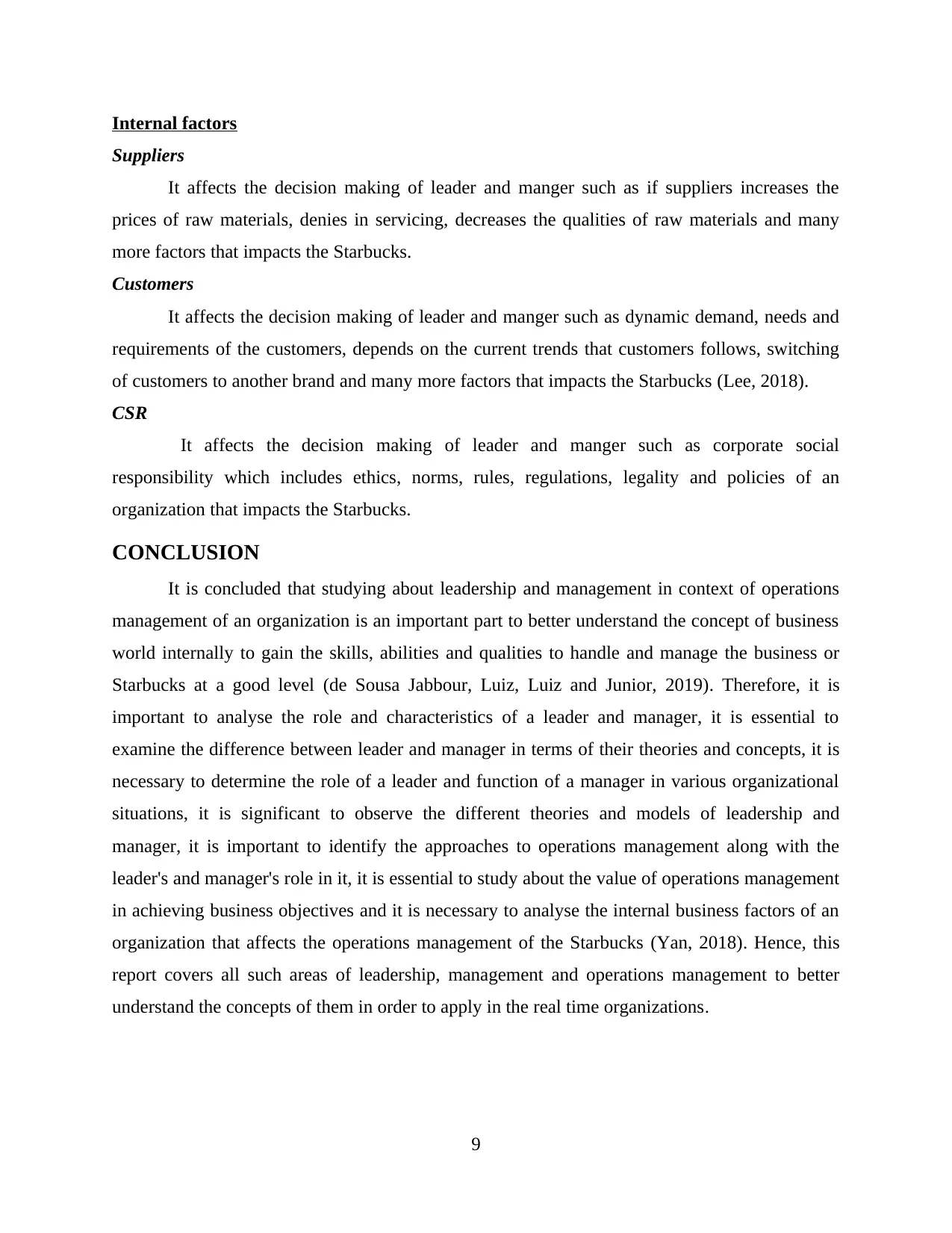
Internal factors
Suppliers
It affects the decision making of leader and manger such as if suppliers increases the
prices of raw materials, denies in servicing, decreases the qualities of raw materials and many
more factors that impacts the Starbucks.
Customers
It affects the decision making of leader and manger such as dynamic demand, needs and
requirements of the customers, depends on the current trends that customers follows, switching
of customers to another brand and many more factors that impacts the Starbucks (Lee, 2018).
CSR
It affects the decision making of leader and manger such as corporate social
responsibility which includes ethics, norms, rules, regulations, legality and policies of an
organization that impacts the Starbucks.
CONCLUSION
It is concluded that studying about leadership and management in context of operations
management of an organization is an important part to better understand the concept of business
world internally to gain the skills, abilities and qualities to handle and manage the business or
Starbucks at a good level (de Sousa Jabbour, Luiz, Luiz and Junior, 2019). Therefore, it is
important to analyse the role and characteristics of a leader and manager, it is essential to
examine the difference between leader and manager in terms of their theories and concepts, it is
necessary to determine the role of a leader and function of a manager in various organizational
situations, it is significant to observe the different theories and models of leadership and
manager, it is important to identify the approaches to operations management along with the
leader's and manager's role in it, it is essential to study about the value of operations management
in achieving business objectives and it is necessary to analyse the internal business factors of an
organization that affects the operations management of the Starbucks (Yan, 2018). Hence, this
report covers all such areas of leadership, management and operations management to better
understand the concepts of them in order to apply in the real time organizations.
9
Suppliers
It affects the decision making of leader and manger such as if suppliers increases the
prices of raw materials, denies in servicing, decreases the qualities of raw materials and many
more factors that impacts the Starbucks.
Customers
It affects the decision making of leader and manger such as dynamic demand, needs and
requirements of the customers, depends on the current trends that customers follows, switching
of customers to another brand and many more factors that impacts the Starbucks (Lee, 2018).
CSR
It affects the decision making of leader and manger such as corporate social
responsibility which includes ethics, norms, rules, regulations, legality and policies of an
organization that impacts the Starbucks.
CONCLUSION
It is concluded that studying about leadership and management in context of operations
management of an organization is an important part to better understand the concept of business
world internally to gain the skills, abilities and qualities to handle and manage the business or
Starbucks at a good level (de Sousa Jabbour, Luiz, Luiz and Junior, 2019). Therefore, it is
important to analyse the role and characteristics of a leader and manager, it is essential to
examine the difference between leader and manager in terms of their theories and concepts, it is
necessary to determine the role of a leader and function of a manager in various organizational
situations, it is significant to observe the different theories and models of leadership and
manager, it is important to identify the approaches to operations management along with the
leader's and manager's role in it, it is essential to study about the value of operations management
in achieving business objectives and it is necessary to analyse the internal business factors of an
organization that affects the operations management of the Starbucks (Yan, 2018). Hence, this
report covers all such areas of leadership, management and operations management to better
understand the concepts of them in order to apply in the real time organizations.
9
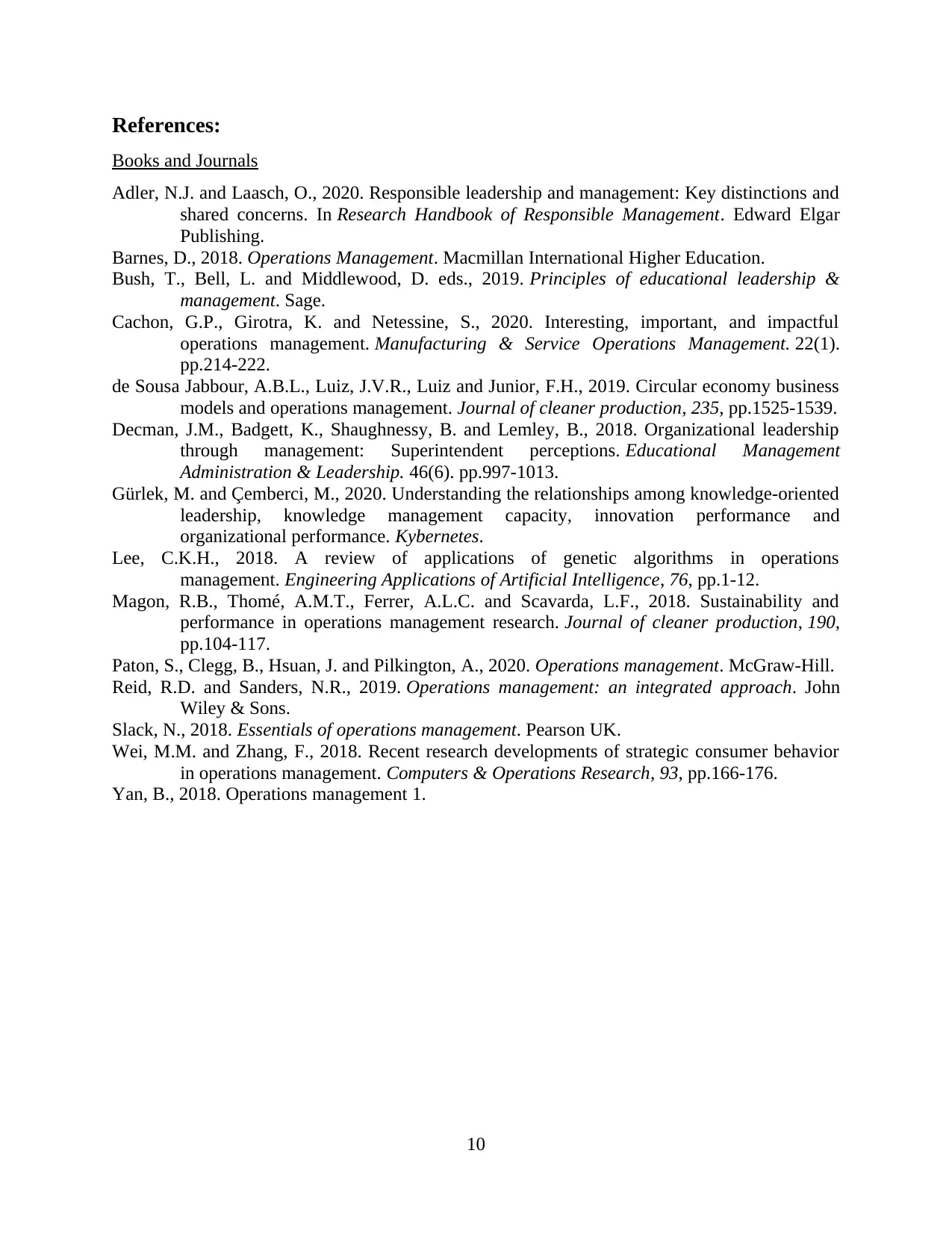
References:
Books and Journals
Adler, N.J. and Laasch, O., 2020. Responsible leadership and management: Key distinctions and
shared concerns. In Research Handbook of Responsible Management. Edward Elgar
Publishing.
Barnes, D., 2018. Operations Management. Macmillan International Higher Education.
Bush, T., Bell, L. and Middlewood, D. eds., 2019. Principles of educational leadership &
management. Sage.
Cachon, G.P., Girotra, K. and Netessine, S., 2020. Interesting, important, and impactful
operations management. Manufacturing & Service Operations Management. 22(1).
pp.214-222.
de Sousa Jabbour, A.B.L., Luiz, J.V.R., Luiz and Junior, F.H., 2019. Circular economy business
models and operations management. Journal of cleaner production, 235, pp.1525-1539.
Decman, J.M., Badgett, K., Shaughnessy, B. and Lemley, B., 2018. Organizational leadership
through management: Superintendent perceptions. Educational Management
Administration & Leadership. 46(6). pp.997-1013.
Gürlek, M. and Çemberci, M., 2020. Understanding the relationships among knowledge-oriented
leadership, knowledge management capacity, innovation performance and
organizational performance. Kybernetes.
Lee, C.K.H., 2018. A review of applications of genetic algorithms in operations
management. Engineering Applications of Artificial Intelligence, 76, pp.1-12.
Magon, R.B., Thomé, A.M.T., Ferrer, A.L.C. and Scavarda, L.F., 2018. Sustainability and
performance in operations management research. Journal of cleaner production, 190,
pp.104-117.
Paton, S., Clegg, B., Hsuan, J. and Pilkington, A., 2020. Operations management. McGraw-Hill.
Reid, R.D. and Sanders, N.R., 2019. Operations management: an integrated approach. John
Wiley & Sons.
Slack, N., 2018. Essentials of operations management. Pearson UK.
Wei, M.M. and Zhang, F., 2018. Recent research developments of strategic consumer behavior
in operations management. Computers & Operations Research, 93, pp.166-176.
Yan, B., 2018. Operations management 1.
10
Books and Journals
Adler, N.J. and Laasch, O., 2020. Responsible leadership and management: Key distinctions and
shared concerns. In Research Handbook of Responsible Management. Edward Elgar
Publishing.
Barnes, D., 2018. Operations Management. Macmillan International Higher Education.
Bush, T., Bell, L. and Middlewood, D. eds., 2019. Principles of educational leadership &
management. Sage.
Cachon, G.P., Girotra, K. and Netessine, S., 2020. Interesting, important, and impactful
operations management. Manufacturing & Service Operations Management. 22(1).
pp.214-222.
de Sousa Jabbour, A.B.L., Luiz, J.V.R., Luiz and Junior, F.H., 2019. Circular economy business
models and operations management. Journal of cleaner production, 235, pp.1525-1539.
Decman, J.M., Badgett, K., Shaughnessy, B. and Lemley, B., 2018. Organizational leadership
through management: Superintendent perceptions. Educational Management
Administration & Leadership. 46(6). pp.997-1013.
Gürlek, M. and Çemberci, M., 2020. Understanding the relationships among knowledge-oriented
leadership, knowledge management capacity, innovation performance and
organizational performance. Kybernetes.
Lee, C.K.H., 2018. A review of applications of genetic algorithms in operations
management. Engineering Applications of Artificial Intelligence, 76, pp.1-12.
Magon, R.B., Thomé, A.M.T., Ferrer, A.L.C. and Scavarda, L.F., 2018. Sustainability and
performance in operations management research. Journal of cleaner production, 190,
pp.104-117.
Paton, S., Clegg, B., Hsuan, J. and Pilkington, A., 2020. Operations management. McGraw-Hill.
Reid, R.D. and Sanders, N.R., 2019. Operations management: an integrated approach. John
Wiley & Sons.
Slack, N., 2018. Essentials of operations management. Pearson UK.
Wei, M.M. and Zhang, F., 2018. Recent research developments of strategic consumer behavior
in operations management. Computers & Operations Research, 93, pp.166-176.
Yan, B., 2018. Operations management 1.
10
⊘ This is a preview!⊘
Do you want full access?
Subscribe today to unlock all pages.

Trusted by 1+ million students worldwide
1 out of 12
Related Documents
Your All-in-One AI-Powered Toolkit for Academic Success.
+13062052269
info@desklib.com
Available 24*7 on WhatsApp / Email
![[object Object]](/_next/static/media/star-bottom.7253800d.svg)
Unlock your academic potential
Copyright © 2020–2025 A2Z Services. All Rights Reserved. Developed and managed by ZUCOL.





